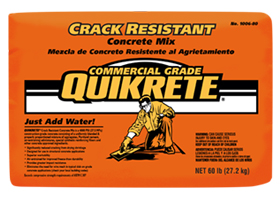

A great way to view and understand your building or repair project before you get started. Find out just about everything you need to know by watching the video below.
Concrete is one of the most economical, versatile and durable building materials available. Build a sidewalk, patio, or floor with QUIKRETE concrete mixes no matter your skill level.

When working with cement-based products, always wear eye protection and waterproof gloves.
Step 1
Prior to placing concrete forms:
Step 2
Check the forms for level (¼ inch for every 12 feet is sufficient to allow for rain run-off). Patio and sidewalk forms should slope evenly away from structures.
Step 3
Evenly spread 3 to 4 inches of QUIKRETE All Purpose Gravel and then level the gravel.
Step 4
Compact the gravel base using a tamper.
TIP: a solid sub-base will help prevent erosion and slab settling.
Step 5
Dampen the gravel base using a garden hose to prevent shrinkage cracking especially in hot temperatures.
Step 6
Pour the concrete mix in evenly placed leads; the top of the concrete mounds should be about 2 to 3 inches above the forms before leveling.
Step 7
Consolidate and distribute the concrete evenly using a hoe. The surface of the concrete should be relatively flat and slightly above the form.
Step 8
Screed the concrete using a straight 2x4 by moving the board back and forth across the surface of the concrete in a sawing motion to remove the excess concrete and smooth the surface.
Step 9
Add concrete to any low areas and screed level.
Step 10
Once the concrete has lost its sheen, smooth the concrete surface using a wood float in an arching motion.
NOTE: use a stiff-bristle broom to create a non-slip broom finish (all broom strokes should be made in the same direction).
Step 11
Cut in control joints using a groover and straight-edge (a 4-inch thick slab will require control joints a minimum of every 10 feet in each direction).
NOTE: control joints should be cut a minimum of ¼ the depth of the slab.
Step 12
Use an edging tool to consolidate and shape the edges of the slab. Several passes should be made in each direction for a smooth finish.
Step 13
Freshly placed concrete should be water cured for a minimum of 3 to 5 days with a fine water mist.
TIP: water curing can be eliminated by applying QUIKRETE Acrylic Concrete Cure & Seal immediately after finishing the concrete. Acrylic Cure & Seal can be applied with a roller, garden sprayer or a brush.